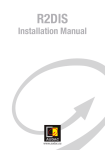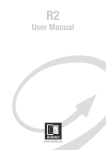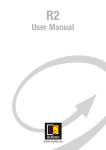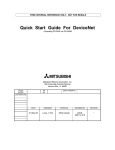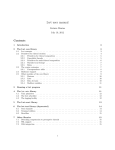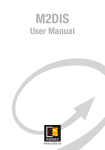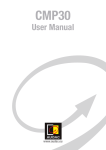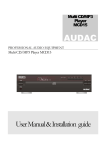Download User Manual - Audiologic
Transcript
R2DIS User Manual www.audac.eu 2 Index Introduction Caution servicing 4 4 User interface Login screen Main screen 5 Zone settings Sound settings Test signals Settings screen Digital input selection Time settings Display configuration Address settings Password settings Factory settings 5 7 10 11 12 13 14 14 15 19 20 21 Notes 22 3 Introduction 7” Touchscreen display kit R2 The R2DIS is an optional display unit with touchscreen which can be installed internally in the front panel of the R2 digital audio matrix system. This unit consists of a 7” TFT display panel with a resolution of 800 x 480 px that is fitted with a resistive touch-screen panel. It is controlled by a powerful 32 bit processor which communicates directly with the DSP processor. This unit allows the user to operate the control functions of the matrix systems without any external equipment. This can be useful when the system is installed in a technical room where no external control devices are within reach. Touchscreen precautions 4 • Tap the touchscreen gently. Never use force. • Don’t use any sharp object to tap the touchscreen. Don’t use a pen, but only use your fingertips or stylus especially meant for use with touchscreens. • Keep the touchscreen dry and clean. Don’t use any abrasives or cleaning solutions to clean it. Only clean it with a soft damp cloth. User interface Login screen 5 A password should be entered to get access to the R2 amplifier. There are two different access levels, administrator level and user level. If you log-in with the administrator password, you get access to all functions and configuration options. (The factory default password for administrator access is “R2”). When you log-in with the user password, you only get access to the basic functions of the main screen, such as changing the volume and changing the routing for a particular output zone. (The factory default password for user access is “user”). After pressing the text field a keyboard screen is displayed, and you can enter the password. After the password is entered, press the “OK” button, and you will be redirected to the main screen of the R2 interface. NOTE The passwords can be changed in the Settings >> Password settings menu (Only administrator) 6 Main screen The main screen displays all 8 output zones of the R2 with fader volume controls Volume control: The volume of each zone can be changed by moving the fader. At the bottom is a “Mute” button to mute the volume of the corresponding output zone. If the zone is muted, the mute button is Red. If the zone is unmuted, the mute button is Green. The mute can be toggled from mute to unmuted by pressing it again. Assign zone names: This option is only available if logged in as “ADMINISTRATOR”. For a better overview of all output zones, every fader has a zone name. The name of the zone can be changed by pressing and holding the name for 2 seconds. After 2 seconds a keyboard screen is displayed to change the name. After changing the name, press “OK”. 7 Press the “Save” button and confirm to save the zone settings. Input channel selection: This option is available if logged in as “ADMINISTRATOR” or “USER”. The desired input signal for a zone can be selected by pressing the button below the zone name. A dropdown list shows 8 audio input signals, together with the options “Off” and “Other”. If logged in as administrator, the list can be changed in the “Zone settings” screen. 8 Zone settings: This option is only available if logged in as “ADMINISTRATOR”. By pressing the “Settings” button, above a slider, the “Zone Settings” screen is displayed. In this window you can select the all input channel for the selected zone. You can also select filters and test signals. Save: This option is only available if logged in as “ADMINISTRATOR”. By pressing this button you can save the settings. To make sure the changed zone settings are still effective after shutdown and restart of the R2, the “Save” button on the main screen of the R2 need to be pressed. At the same time, the volume and routing settings will be saved. Setup: This option is only available if logged in as “ADMINISTRATOR”. In the top right corner is a “Setup” button displayed. After pressing this button, you will be redirected to the configuration menu of the R2. Info Info: Pressing the AUDAC logo will show the info screen. 9 Zone Settings This option is only available if logged in as “ADMINISTRATOR”. By pressing the “Settings” button, above a slider, the “Zone Settings” screen is displayed. In this window you can select an input channel for the selected zone. Input channel selection: The screen gives an overview of all input channels that can be patched to the output zone. You can select “Cinch inputs”, “Wall inputs” , “Fiber inputs”, “No Input” and “S/PDIF” . 10 • If “No Input” is selected, the output zone is muted. • If “S/PDIF” is selected the optical or coaxial input will be routed to the output zone. (The selection between the optical or coaxial input should be made in the “Setup Menu” under “Digital Input”). • If one of the 8 analog “Cinch Inputs” is selected the corresponding RCA connector input on the rear panel of the R2 is routed to the output zone. If one of the 8 “Wall Inputs” is selected the corresponding RJ45 PI connector for Paging or wall input is routed to the output zone. • If one of the 8 “Fibre Inputs” (Only if the optional R2OPT module is installed) is selected, a signal from the fibre interconnection interface can be patched to the selected output zone. Zone settings >> Sound settings The “Sound Settings” window offers the possibility to apply a digital filter to the selected output zone, and to adjust the sound with a two-band tone control. Digital Filter: Press the “Enable Filter” checkbox to enable the filter and select the desired filter type “High-Pass”, “Low-Pass” or “Band-Pass”. The graphics will show the selected filter. The crossover frequency can be adjusted by sliding the button on the slider scale. The frequency can be set between 10Hz and 22kHz, the crossover frequency is displayed on the right side of the slider scale. Two band tone control: On the right of the screen there are 2 sliders for tone control. The leftmost fader indicated with “Bass” offers the possibility to adjust the level of the low frequencies. The rightmost fader indicated with “Treble” offers the possibility to adjust the level of the high frequencies. The sound level level for both low and high tones can amplified or attenuated between +9 dB and -9 dB. DSP load: When adding filters, the DSP load increases. If the load is greater than 90%, the filter will not be used.Zone settings >> Test signals 11 Zone settings >> Test signals The R2 has an internal digital signal generator which can generate white noise, pink noise and sinusoidal signals with a selectable frequency. Each of those signals can be patched to any output zone. When one of the test signals is selected, “Other” will appear in the ‘Input Selection” box on the main screen. 12 • Select “white noise” to route white noise to the output zone. • Select “pink noise” to route pink noise to the output zone. • Select “Sine Generator” to route a sine wave to the output zone. The frequency of the sine wave can be changed by the up and down arrows. Settings screen The settings screen is displayed by pressing the “Setup” button. This button is always shown in the upper right corner of every window. (Only on Administrator level). In this window, the next settings can be changed: • Select the digital input source. • Change the time of the R2. • Configure the LCD. • Set the address of the R2 amplifier. • Change the password of the R2. • Restore the factory settings of the R2. If you want to change some settings, just click on the corresponding icon. All settings will be saved automatically and are still effective after shutdown and restart of the R2. 13 Settings >> Digital input selection In this window, the desired digital S/PDIF audio input can be selected. The S/PDIF input can be: • Coaxial implemented with an RCA connector. • Optical implemented with a Toslink connector. Settings >> Time settings In this window, the time and date of the R2 can be set. This can be done by selecting the values from a dropdown list. Press “Set Clock” to set time and date. 14 Settings >> Display configuration This window configures the display unit screen, not the R2. The settings must be save by pressing the “SAVE” button. The next items can be set: • Panel brightness: Sets the brightness of the backlight. • Auto Logoff: When enabled, the system logs off after some time of no activity. The administrator has to log on again. Push “Logoff time” to change the time. • Limited control: When enabled, there is no logon screen. At start up the main screen is shown. The user can only change volume and mute. For other functions, the password will be asked. • Keyboard Type 3 types of keyboard can be selected: “AZERTY” “QWERTY” “ABC” 15 • Screensaver 2 types can be selected: “Off” “Clock” If Clock is selected, after some time an analog clock is shown. The time can be configured in ”Screensaver time”. • 16 Update software With this button the firmware of the display unit will be updated, not the firmware of the R2. The software can be updated by placing a USB memory stick in the USB port at the rear side of the display unit, and holding the “Update software” button for 3 seconds. After 3 seconds an update screen appears and the system starts updating. When finished updating, the display unit restarts and a login screen appears. • Calibration If the touchscreen isn’t working accurate, it must be calibrated. The calibration must be done by a stylus which is meant for use with touchscreens. The cross shown in the diplay needs to be touched three times in a row to calibrate the touchscreen correctly. To make an accurate calibration, it should be touched exactly at the center position of the cross. ATTENTION Don’t use any sharp object to tap the touchscreen. Don’t use a pen, but only use your fingertips or stylus especially meant for use with touchscreens. The use of sharp objects can cause permanent damage to the touchscreen. 17 • 18 Test R2DIS In this window, the complete functionality of the display unit can be tested. The ‘REAL TIME CLOCK’ indicator must be green. The ‘COMMUNICATION’ indicator must be green. The ‘EEPROM’ indicator must be green. When a USB memory stick is inserted (to the USB port at the back side of the display unit ) this indicator should also be green. The dimming of the backlight can be tested by moving the slider. The touchscreen can be tested by making a drawing in the white field. Use the “Clear” button to erase the field. Use the “Update software” button to update the software of R2DIS. Use the “Calibration” button to calibrate the touchscreen. Use the “BACK” to return back to the previous screen. Settings >> Address settings In this menu, the address of the R2 can be set. This address default is “001” and is selectable between “001” and “999”. When only one R2 is available, the default address can be left to its default value. When two or more R2’s are cascaded through the fibre interconnection bus, they need to have a unique address. The first R2 starts with address “001”, and every subsequent R2 should be assigned an address with a higher value. Click the “OK” button to confirm the address settings. 19 Settings >> Password settings In this window the passwords for the R2 can be changed. There are two different password levels: Administrator level which has full access to all functions and User level, which has only access to the basic functions. On the left side of the window the settings for the Administrator password can be changed, while on the right side the settings for the User password can be changed. For changing the password, enter the old password in the provided field, and enter the new password twice in the provided fields. After this all is completed, push the “OK” button. When the old password is correct, and the new password filled in both fields match, the old password will be changed into the new password. The factory default password for Administrator is “R2” and for User is “user”. If the new password is left blank, the user must not log in. NOTE Be careful with leaving the admin password blank as everybody has access to the settings. 20 Settings >> Factory settings BE CAREFULL to press this button. It will recall the ORIGINAL factory settings !!! It does not recall the previously saved settings, but it recalls the original factory setting and the previous made settings will be lost. Click the “OK” button to reset the settings to factory default. 21 Notes 22 Notes 23 Notes 24
























